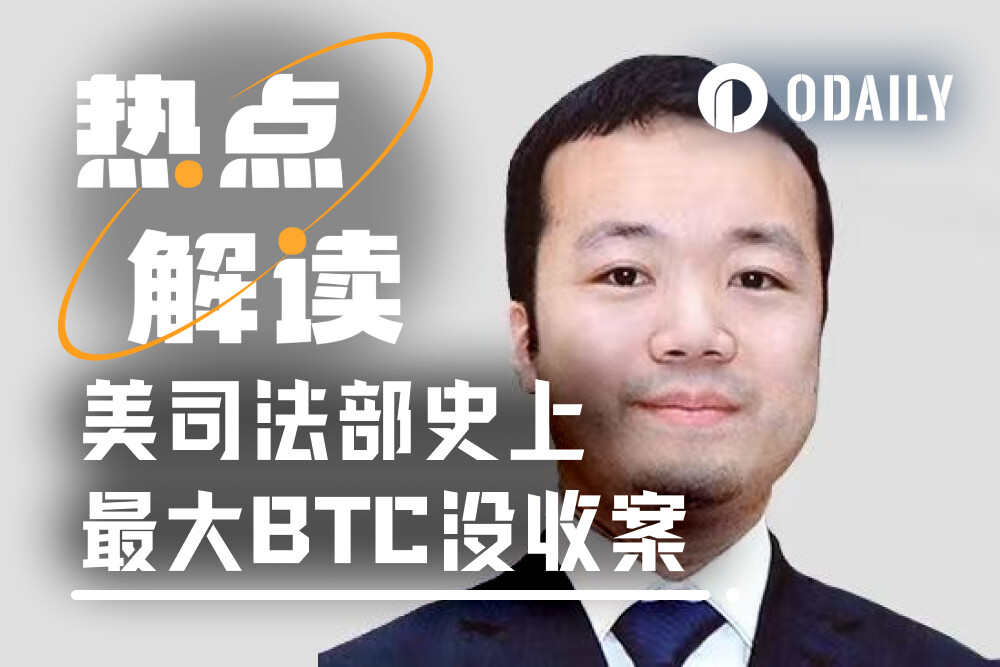Original | Odaily Planet Daily (@OdailyChina)
Author | Ethan (@ethanzhangweb3)_

A lawsuit from the Federal Court for the Eastern District of New York has stirred up a storm in the crypto world.
On October 14, the U.S. Department of Justice announced criminal charges against Chen Zhi, the founder of the Prince Group in Cambodia, and applied to seize 127,271 BTC under his control, valued at approximately $15 billion, making it the largest judicial seizure of Bitcoin in the world.
“The most significant virtual asset seizure in history.” The Department of Justice used highly cautionary language in its announcement. Furthermore, officials emphasized that this batch of BTC was not stored on a trading platform but was long held by Chen himself through an unmanaged private wallet. This seems to shake the core belief of the crypto community: “If you hold the private key, the asset is unseizable.”
In fact, even without cracking encryption algorithms, the U.S. government can still complete the “judicial transfer” of assets through legal procedures. Through on-chain tracking and international cooperation, law enforcement agencies identified Bitcoin scattered across multiple addresses, all controlled by Chen Zhi. The court subsequently issued a seizure order, legally transferring these assets to an address controlled by the U.S. government, entering judicial custody, and awaiting a final civil forfeiture judgment.
Meanwhile, the U.S. Treasury Department's Office of Foreign Assets Control designated the “Prince Group” as a transnational criminal organization and imposed sanctions on 146 related individuals and entities; the Financial Crimes Enforcement Network classified Huione Group as a “primary money laundering concern” under the Patriot Act, prohibiting it from accessing the U.S. dollar clearing system. The UK also simultaneously executed asset freezes and travel bans against Chen Zhi and his family members.
In the context of the crypto market, this moment is highly symbolic. It is not only law enforcement against a criminal group but also a public demonstration of state agencies exercising direct control over on-chain assets. The number 127,271 BTC—capable of changing market sentiment and regulatory direction—has been inscribed in the history of Bitcoin regulation, becoming a key marker.
From Fujian Merchant to Fraud Empire: Chen Zhi's Capital Layout and Industrialized Crimes
The indictment from the U.S. Department of Justice reveals another face of Chen Zhi and his Prince Group.
According to reports from Southeast Asian media, Chen Zhi was once a “new noble in Cambodia,” and the Prince Group he controlled was promoted as a multinational conglomerate with businesses spanning real estate, finance, and more. However, the U.S. Department of Justice alleges that behind this facade lies a “dual operating logic”: externally, it is a legitimate business empire, while internally, it serves as a funding control and clearing system for fraud proceeds.
Originally from Fujian, Chen Zhi made his fortune in Cambodia through the gambling and real estate industries. After obtaining Cambodian citizenship in 2014, he quickly acquired multiple development permits and financial licenses through political and business connections. He did not stop at local operations but instead established a complex multinational asset allocation through setting up companies in the British Virgin Islands and a holding structure in Singapore, and he is suspected of holding British identity, thus creating barriers between different jurisdictions. In April 2024, the King of Cambodia even issued a royal decree appointing Chen Zhi as an advisor to Prime Minister Hun Sen of the Senate, demonstrating his deep political and business roots in the region.

King Norodom Sihamoni of Cambodia issued a royal decree on April 19, 2024, appointing Prince Group Chairman Chen Zhi as an advisor to Prime Minister Hun Sen of the Senate.
According to the allegations, the telecom fraud system established by Chen Zhi in Cambodia operates in a “industrialized” manner. The Department of Justice documents repeatedly mention the concepts of “parks” and “phone farms,” with a highly systematic operational model:
- Physical Bases: The so-called “parks” are registered under the guise of outsourcing services but are actually managed in a closed manner.
- Labor Control: Foreign workers are “highly recruited” to come to the country, often facing restrictions on their personal freedom.
- Standardized Operations: Operators manage hundreds of “relationship lines,” using a unified script for social inducement and investment guidance, similar to customer relationship management processes.
- Technical Disguise: “Phone farms” utilize a large number of SIM cards and IP proxies to create virtual identities and geographical locations, concealing the true source.
This is not a traditional disorganized fraud gang but a clearly defined “on-chain fraud factory.” All fraud proceeds ultimately flow into the financial intermediary layer of the Prince Group. Reports indicate that Chen Zhi's criminal gains were used for extremely luxurious consumption, including purchasing luxury watches, yachts, private jets, and even a Picasso painting auctioned in New York.

Overview of the two-tier business structure of Prince Group.
Funding Source: From Hacker Heist to Fraud Laundering
The origin of the 127,271 BTC in this case is particularly complex. According to reports from on-chain analysis firms such as Elliptic and Arkham Intelligence, this batch of Bitcoin is highly correlated with a theft incident involving a large mining company called “LuBian” in 2020.
Records show that in December 2020, an abnormal transfer occurred in LuBian's core wallet, resulting in approximately 127,426 BTC being stolen. On-chain, there was even a small transaction sent from LuBian to the hacker's address with the message: “Please return our funds, we'll pay a reward.” After that, this large sum of money remained dormant for a long time, only becoming active in mid-2024, with its movement path overlapping with the wallet cluster controlled by the Prince Group. _(Latest update: On October 15, _the LuBian-related wallet transferred all 9,757 BTC, worth $1.1 billion, after three years of dormancy)
This indicates that the investigation reveals not a simple “fraud-laundering” chain but a more complex path: “Hacker heist of the mining site → Long-term lurking → Inclusion into the funding pool by a criminal organization → Attempt to launder through mining and over-the-counter trading.” This finding elevates the case to a new level of complexity: it involves both hacking attacks and mining security vulnerabilities, and reveals how gray exchange networks absorb and hide large amounts of unusually sourced funds.
How Was the Bitcoin Seized?
For the cryptocurrency industry, the far-reaching impact of this case goes beyond taking down a fraud kingpin; it lies in the complete demonstration by judicial and intelligence agencies of a process for handling on-chain assets: On-chain positioning → Financial blockade → Judicial takeover. This is a practical closed loop that seamlessly connects “on-chain tracking capabilities” with “traditional judicial power.”
Step One: On-chain Tracking—Locking Down the “Funding Containers”
The anonymity of Bitcoin is often misunderstood. In fact, its blockchain is a public ledger, and every transaction leaves a trace. Chen Zhi's group attempted to launder money using the classic “spray-funnel” model: dispersing funds from the main wallet to a vast number of intermediate addresses like watering with a spray can, and after a brief stay, re-aggregating to at least a few core addresses like streams converging into a river.
This operation seems complex, but from the perspective of on-chain analysis, frequent “dispersal-aggregation” actions actually create unique pattern characteristics. Investigative agencies (such as TRM Labs, Chainalysis) use clustering algorithms to accurately map out the “funds return map,” ultimately confirming that these seemingly dispersed addresses all point to the same controlling entity—the Prince Group.
Step Two: Financial Sanctions—Cutting Off the “Monetization Channels”
After locking down the on-chain assets, U.S. authorities initiated dual financial sanctions:
- Treasury Department (OFAC) Sanctions: Chen Zhi and related entities were listed, prohibiting any U.S.-jurisdictional entities from transacting with them.
- Financial Crimes Enforcement Network (FinCEN) §311 Clause: Key entities were designated as “primary money laundering concerns,” completely cutting off their access to the U.S. dollar clearing system.
At this point, although these Bitcoins can still be controlled by private keys on-chain, their most important value attribute—the “ability to be exchanged for U.S. dollars”—has been frozen.
Step Three: Judicial Takeover—Completing the “Ownership Transfer”
The final seizure was not achieved through violent cracking of private keys but through legal procedures directly taking over the “signing rights.” Law enforcement obtained mnemonic phrases, hardware wallets, or transaction permissions based on search warrants, and then initiated a legal transfer transaction, moving the Bitcoin to a government-controlled custody address, just like the original owner would.
When this transaction was confirmed by the blockchain network, “legal ownership” and “on-chain control” were unified. The ownership of these 127,271 BTC was officially transferred from Chen Zhi to the U.S. government in both technical and legal terms. This combination clearly indicates: in the face of state power, “on-chain assets are unseizable” is not absolute.

Where Will the Bitcoin Go After Seizure?
After 127,271 BTC was transferred from the fraud empire's wallet to the “U.S. Government Controlled Wallet,” a more strategically significant question arises: the final destination of this massive asset will reveal how the U.S. government positions Bitcoin—whether it is a “stolen property” that needs to be liquidated or a “strategic asset” to be acquired.
Historically, the U.S. government has handled seized digital assets in several ways. The Bitcoin from the Silk Road case was transferred to private institutional investors through public auctions after completing judicial procedures, with Tim Draper being one of the auction buyers. The BTC from the Colonial Pipeline ransom was temporarily kept in government accounts by the Department of Justice after recovery, used as evidence for the case and for Treasury Department records. As for FTX, its current status remains in judicial custody, and the official has not confirmed the confiscated assets as government property; most of these assets theoretically should be used for user compensation within the creditor liquidation process rather than directly included in the treasury reserves.
Unlike the method of handling seized Bitcoin through public auctions (such as in the Silk Road case), this case faces a key variable: In March 2025, the White House signed an executive order establishing a “strategic Bitcoin reserve” mechanism. This means that the BTC in the Chen Zhi case is likely to be converted directly into reserve assets held by the state rather than being simply auctioned off.
As a result, the U.S. is constructing an unprecedented “on-chain asset regulatory closed loop”: locking down targets through on-chain tracking—using sanctions to cut off their fiat currency export—completing the legal deprivation of ownership through judicial procedures—and ultimately transferring the assets into government control. The core of this process is not to restrict market circulation but to redefine the legal ownership of “key control.”
Once the judicial process confirms the assets as criminal proceeds, their nature shifts from “cryptocurrency under personal control” to “digital asset certificates under national jurisdiction.”
With the transfer of 127,271 BTC, the U.S. has become the sovereign entity holding the most Bitcoin globally. This is not only an unprecedented seizure action but also signifies the beginning of an era where state power systematically controls on-chain assets.
Related Reading
“The Largest BTC Theft Case in History Exposed: Hidden for 5 Years, Involving $14.5 Billion”
免责声明:本文章仅代表作者个人观点,不代表本平台的立场和观点。本文章仅供信息分享,不构成对任何人的任何投资建议。用户与作者之间的任何争议,与本平台无关。如网页中刊载的文章或图片涉及侵权,请提供相关的权利证明和身份证明发送邮件到support@aicoin.com,本平台相关工作人员将会进行核查。




